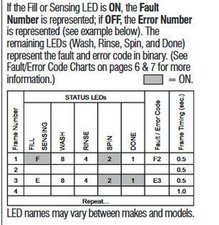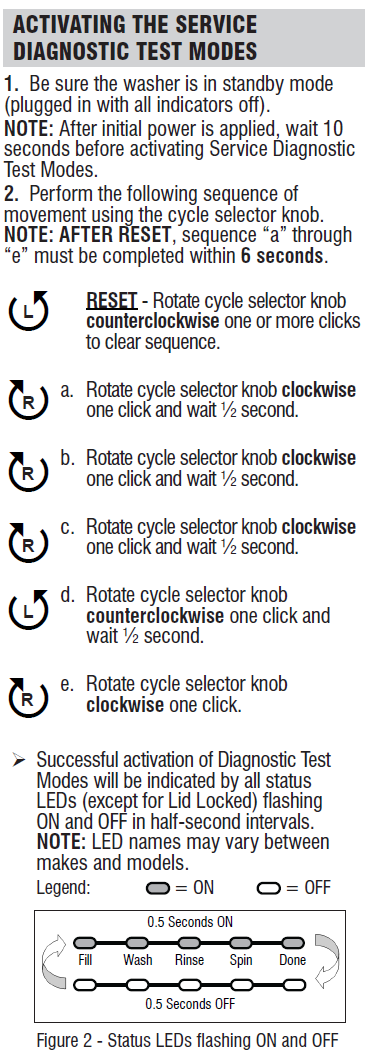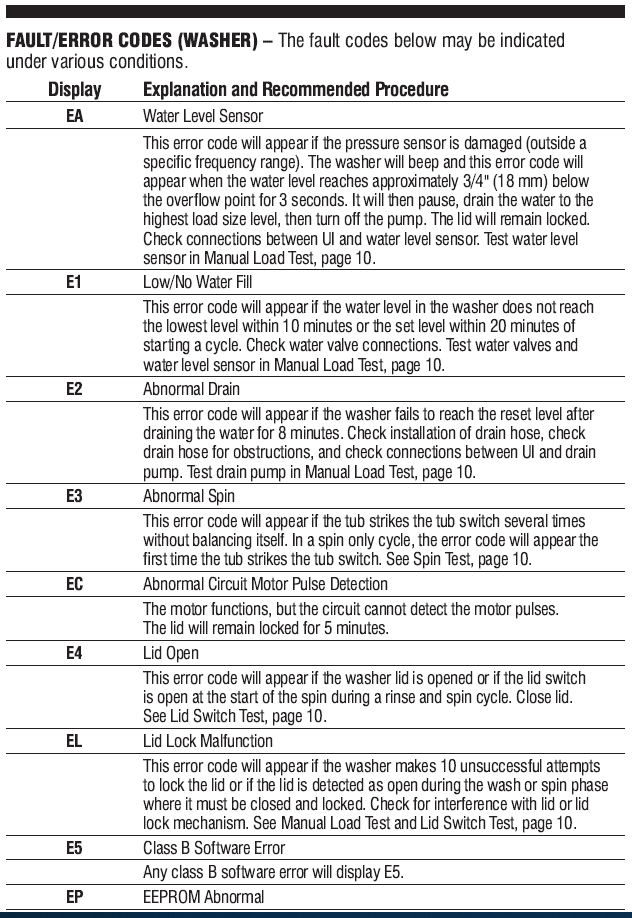Imagine this: you’re ready to tackle that ever-growing pile of laundry, but your Whirlpool washer has other plans. A mysterious error code flashes on the display, leaving you puzzled and a bit frustrated.
You might feel stuck, wondering what went wrong and how to fix it. Don’t worry, you’re not alone. Understanding Whirlpool washer error codes can feel like deciphering a secret language, but it doesn’t have to be that way. By the end of this article, you’ll know exactly what those codes mean and how to resolve them.
So, let’s dive in and get your washer back to doing what it does best—making your life easier.

Credit: www.ifixit.com
Common Error Codes
Whirlpool washers are reliable but can face occasional issues. Error codes help diagnose these problems. Understanding these codes is essential for quick fixes. Let’s explore some common error codes.
F01: Electrical Circuit Issue
The F01 code signals an electrical problem. It may involve the control board. Check for loose wires or burnt connections. Ensure everything is securely plugged in. If issues persist, professional help might be needed.
F02: Drainage Problem
F02 indicates a drainage issue. The washer might not drain water properly. Check the drain hose for clogs. Clean the pump filter if necessary. Inspect the drain pump for blockages. Fixing these can clear the error.
F03: Temperature Sensor Failure
An F03 code relates to the temperature sensor. The sensor might be faulty or disconnected. Inspect the wiring connected to the sensor. Replace the sensor if it’s damaged. Ensure the connections are tight.
F05: Water Overflow
F05 suggests a water overflow issue. This could be due to a faulty water inlet valve. Check for any leaks or blockages in the inlet. Ensure the water level sensor functions correctly. Taking these steps can resolve the problem.
Identifying Error Codes
Whirlpool washers are popular for their efficiency and reliability. Yet, they sometimes show error codes. These codes help diagnose specific issues with the machine. Knowing how to identify these codes is crucial. It allows you to fix problems and maintain your washer’s performance.
Using Display Panel
The display panel is key to finding error codes. It shows numbers or letters when an issue occurs. Look at the panel after an error. Check the code displayed. This is the first step in troubleshooting your washer.
Understanding Code Patterns
Error codes follow certain patterns. These patterns help you understand the problem quickly. For example, an “F” followed by a number often indicates a fault. Knowing these patterns saves time. It also helps you decide if professional help is needed.
Troubleshooting Basics
Understanding Whirlpool washer error codes can save time and money. These codes help identify specific issues with your washer. Knowing how to troubleshoot them is crucial. This guide will walk you through the basics of troubleshooting these errors. You will learn about safety, tools, and steps needed. Let’s dive in and fix those pesky error codes.
Safety Precautions
Before starting, always unplug the washer. This prevents electrical shocks. Ensure the water supply is off. This avoids flooding or leaks. Wear gloves to protect your hands. Keep children and pets away from the work area. Safety first at all times.
Tools Required
Having the right tools makes the job easier. You will need a screwdriver. A multimeter is useful for checking electrical components. Pliers can help with tight fittings. Keep a flashlight handy for better visibility. These basic tools should suffice for most tasks.
Fixing Electrical Issues
Whirlpool washers are known for their reliability. But electrical issues can disrupt their functionality. Understanding error codes helps diagnose these problems swiftly. Addressing electrical issues ensures your washer runs smoothly again. Focus on key areas to resolve common electrical problems.
Resetting The Washer
Sometimes, a simple reset solves many issues. Disconnect the washer from power. Wait for a few minutes. Plug it back in. This action often clears minor glitches. Follow your manual’s instructions for specific reset steps. This process refreshes the system.
Inspecting Wiring Connections
Loose wires can cause errors in Whirlpool washers. Check the wiring connections inside the machine. Ensure all wires are firmly attached. Look for signs of wear or damage. Replace any damaged wires immediately. This inspection prevents future electrical problems.
Resolving Drainage Problems
Whirlpool washer error codes can signal drainage issues that need attention. Identifying these codes helps resolve problems efficiently. Regular maintenance and understanding error signals ensure smooth washer operation.
Resolving drainage problems in your Whirlpool washer can feel overwhelming. But don’t worry. With a few steps, you can solve these issues. Drainage problems often cause error codes to appear. They can affect your washer’s performance.Checking Drain Hose
Begin by inspecting the drain hose. Ensure it is not kinked or bent. A twisted hose can block water flow. This can cause drainage issues. Look for any clogs inside the hose. Debris can easily get stuck. Remove the hose and clear any blockages. This simple check often resolves many drainage problems.Cleaning The Pump Filter
Next, focus on the pump filter. It can get clogged with lint and debris. This blockage prevents water from draining. Locate the pump filter on your washer. Usually, it’s at the bottom front. Carefully remove and clean it. Rinse the filter under running water. Ensure it is free of all debris. Reinstall the filter securely. Regular cleaning keeps your washer running smoothly. Following these steps can help fix drainage issues. Keep your washer in top condition. A little maintenance goes a long way.
Credit: nelihome.com
Addressing Sensor Failures
Addressing sensor failures in your Whirlpool washer is crucial. These sensors help your washer run smoothly. When they fail, your machine may not work properly. This can lead to issues like incorrect water temperature or improper load balance. Identifying and addressing these sensor failures is essential for maintaining your washer’s performance. Let’s explore some solutions.
Replacing Temperature Sensor
The temperature sensor ensures the water is at the right temperature. If it’s faulty, the water may be too hot or too cold. First, unplug the washer for safety. Locate the temperature sensor near the water inlet valve. Carefully remove the faulty sensor. Install a new sensor in its place. Reconnect any wires securely. Plug the washer back in. Test the washer to ensure proper temperature control.
Calibrating Sensors
Sometimes, sensors need recalibration. This process aligns them with the washer’s settings. Start by turning off the washer. Locate the control panel on your machine. Enter the diagnostic mode as per the manual. Follow the steps to recalibrate the sensors. This may involve pressing specific buttons in sequence. Once done, restart your washer. Check if the sensor readings are accurate now. Regular calibration keeps your machine efficient.
Handling Water Overflow
Water overflow in Whirlpool washers often triggers specific error codes. These codes help identify issues like drainage problems or malfunctioning sensors. Understanding these codes can prevent damage and ensure your washer operates efficiently.
Handling water overflow in your Whirlpool washer can be a daunting task, but with the right steps, you can tackle it effectively. Imagine coming home after a long day, only to find your laundry room flooded. It’s frustrating, but understanding why it happens and how to fix it can save you time and stress. Let’s dive into the practical steps you can take to handle water overflow in your washer.Adjusting Water Level
Have you ever wondered why your washer fills up more than it should? One common reason is an incorrect water level setting. Check your washer’s settings and ensure it’s aligned with the load size. If your washer is overfilling, adjust the water level to match the size of your laundry load. For smaller loads, use a lower water level to prevent overflow. This simple adjustment can prevent excess water from spilling out and causing a mess.Inspecting Water Inlet Valve
Another culprit for water overflow could be the water inlet valve. This tiny component controls the flow of water into your washer. If it’s malfunctioning, you might experience overflow issues. Check the water inlet valve for any signs of wear or damage. Is it opening and closing properly? If not, it might need replacement. You can test the valve by turning off the washer and disconnecting the hoses. See if the valve is clogged or not sealing tightly. Addressing this issue can help you keep your laundry area dry and functional. In your experience, how often do you check your washer for potential issues? Regular maintenance can prevent unexpected surprises. Handling water overflow is not just about fixing problems; it’s about proactive care for your appliances.Maintenance Tips
Encountering Whirlpool washer error codes can be frustrating. Understanding these codes helps in identifying common issues. Regularly clean the filter and ensure balanced loads to prevent errors.
Maintaining your Whirlpool washer is essential for its longevity and efficiency. Error codes are often a sign that something needs attention. By keeping up with maintenance, you can prevent these interruptions. It doesn’t have to be time-consuming or complex. A few simple steps can make a big difference.Regular Cleaning
Regular cleaning is key to a well-functioning washer. Start by wiping down the exterior with a damp cloth to remove dust and detergent residue. Inside the drum, run an empty hot wash cycle with a cup of white vinegar. This helps remove soap scum and odors. Don’t forget to clean the detergent dispenser too. Simply remove it and rinse thoroughly under warm water. Do you notice any moldy smells? That’s a sign of trapped moisture. Leave the door open after each wash to let the inside air out. It’s a small habit that can prevent mildew buildup.Periodic Inspections
Periodic inspections can catch issues before they become problems. Check the hoses for any signs of wear or leaks. A small crack can lead to a big mess. Feel the hoses with your fingers; they should be pliable and not brittle. Take a moment to inspect the door seal. Look for any tears or trapped debris. A clean and intact seal ensures your washer remains leak-free. Have you ever found a forgotten sock stuck in there? It happens more often than you think. Don’t overlook the filter. A clogged filter can lead to error codes and poor performance. Consult your manual to locate and clean it. This quick step can improve water drainage and efficiency. By following these maintenance tips, you’re not just preventing error codes; you’re enhancing your washer’s performance. Are there other maintenance routines you’ve tried that worked well? Share your experiences and help others keep their washers running smoothly.Professional Assistance
Experiencing Whirlpool washer error codes can be puzzling. Expert help simplifies understanding and resolving these issues. Professional assistance ensures your washer operates smoothly, saving time and stress.
Understanding Whirlpool washer error codes can be a game-changer when it comes to maintaining the efficiency of your appliance. However, there are times when these codes indicate issues that go beyond DIY solutions, signaling the need for professional assistance. Knowing when and how to seek expert help can save both time and money, ensuring your appliance is back in top shape without unnecessary stress.When To Call A Technician
If your washer displays persistent error codes despite your troubleshooting efforts, it might be time to call a technician. Repeated issues could indicate underlying problems that require specialized tools and expertise. Don’t let your appliance suffer further damage by delaying professional intervention. Water leakage and electrical errors are serious matters. If you notice any of these, contact a qualified technician immediately. Ignoring these signs can lead to safety hazards or costly repairs down the line. When your washer’s performance deteriorates, it’s better to seek help sooner rather than later. A professional can diagnose and fix the problem efficiently, ensuring your appliance continues to serve you well.Choosing Reliable Service
Finding a trustworthy service provider can be daunting, but it’s crucial for effective repairs. Look for technicians with positive reviews and certifications from recognized institutions. This ensures they have the skills and knowledge to handle your specific model. Ask friends or family for recommendations. Personal experiences can provide valuable insights into the quality of service you can expect. Verify warranties or service guarantees before committing. Reliable services often offer these as a testament to their confidence in delivering quality work. Remember, it’s important to weigh the cost of repair versus replacement. A qualified technician can help you decide the best course of action, potentially saving you money in the long run. Have you ever faced a situation where professional help was your best bet? Share your experiences in the comments below!
Credit: nelihome.com
Frequently Asked Questions
What Do Whirlpool Washer Error Codes Mean?
Error codes show problems in the washer. They help identify issues like draining, door lock, or motor problems.
How Can I Fix Whirlpool Error Code F01?
F01 indicates a control board issue. Try resetting the washer. Unplug for 10 minutes then plug back in.
Why Does My Whirlpool Washer Show Error Code E01?
E01 error often means a door lock issue. Check if the door is closed properly or needs repair.
How To Troubleshoot Whirlpool Error Code F21?
F21 signals a draining problem. Clean the drain filter. Ensure hoses are not clogged or kinked.
Is Error Code Ld Serious In Whirlpool Washers?
Yes, LD means long drain. Check for drain blockages or pump malfunctions. Ensure water exits correctly.
Conclusion
Understanding Whirlpool washer error codes helps solve common problems quickly. These codes guide you through troubleshooting and fixing issues. Regular maintenance reduces the risk of errors. Keep your manual handy for reference. A little patience goes a long way when dealing with technical glitches.
Always unplug the washer before attempting repairs. Contact a professional if unsure about handling complex issues. Take a proactive approach to maintain your washer’s efficiency. Save time and avoid frustration by learning these codes. Enjoy smoother laundry days with fewer interruptions.
Happy washing!
